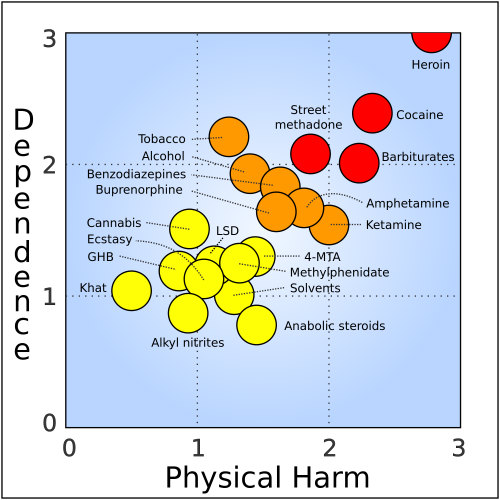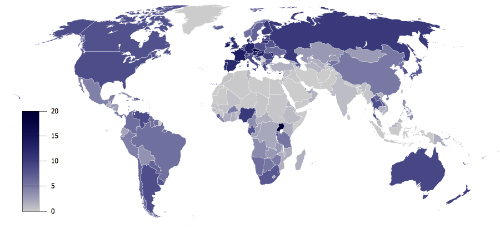- The Preventure program has been shown to reduce substance abuse among adolescents.
- Identification of 4 personality traits along with intervention related to those traits reduces rates of substance abuse.
- Program has been studied in randomized controlled trials in schools in the U.K.
This year marks the 30th anniversary of the establishment of a nationwide drinking age of 21 in the U.S., focusing attention on substance abuse disorders. Since the new drinking age was implemented, clinicians have come to recognize that intervention early in life can help prevent substance use disorders from become lifelong burdens. A number of studies have come to light that offer ways to improve early intervention.

(Sources: Wikipedia/By Alexis Barrera (Al Bar) of Oaktown Crack Comics/Creative Commons.)
The Substance Use Risk Profile Scale
A new antidrug program tested in Europe, Australia and Canada is showing promise. Called Preventure the program has been developed by Patricia Conrod, PhD and her colleagues. Dr. Conrod is Professor of Psychiatry at the University of Montreal. According to Dr. Conrod’s research, a child’s temperament drives his or her risk for drug use. Different traits of personality or temperament create different pathways to addiction. Four traits specifically appear to be predictors of a young person’s risk: hopelessness, anxiety sensitivity, impulsivity, and sensation seeking.
The Substance Use Risk Profile Scale (SURPS) appears to be useful for detecting these traits and predicting later substance misuse disorders, according to Dr. Conrod and colleagues. They conducted a study of the efficacy of the program for preventing the development of substance abuse disorders through early identification of those at risk. The study was published in 2013 in Alcoholism: Clinical and Experimental Research.
The researchers studied the validity, sensitivity, and specificity of the Substance Use Risk Profile Scale (SURPS) for prediction or early detection of an individual’s risk of substance abuse. They tested the concurrent and predictive validity of the SURPS scale in a sample of 1,162 adolescents (mean age: 13.7 years) using linear and logistic regression analyses. They tested the sensitivity and specificity of the scale using receiver operating characteristics curve analyses.
Results showed a high sensitivity. When using the 4 SURPS subscales—hopelessness, anxiety sensitivity, impulsivity, and sensation seeking—to identify adolescents at risk sensitivity scores ranged from 72% to 91%. The scale also had high specificity in this study when using the individual personality subscales. For instance, most adolescents who were identified to be at high risk by the impulsivity scale developed conduct or drug use problems within the next 18 months, yielding a specificity score of 70% to 80%.
“The SURPS is a valuable tool for identifying adolescents at high risk for substance misuse and other emotional and behavioral problems,” the authors concluded. The SURPs became the foundation of the Preventure model for preventing substance abuse disorders in adolescents and teens.

Based on data from The Lancet. 2007;369:1047-1053.
(Sources: Wikipedia/By Apartmento2/Public Domain.)
Preventure
Preventure is a substance abuse prevention program devised by Dr. Conrod and based on that like those gleaned from the SURPS trial. The program, which has thus far been implemented in schools, begins with an intensive 2-3-day training session for teachers. Teachers are taught to spot the 4 traits that Dr. Conrod’s research has found to be associated with substance abuse disorders. “The idea is to prevent people with outlying personalities from becoming entrenched in disordered thinking that can lead to a diagnosis, or, in the case of sensation-seeking, to dangerous behavior,” according to a recent article about Preventure in The New York Times.
Randomized Controlled Trials
Preventure was tested in a 24-month cluster randomized controlled trial that was reported in JAMA Psychiatry in 2013. The publication was titled “Effectiveness of a selective, personality-targeted prevention program for adolescent alcohol use and misuse: a cluster randomized controlled trial.”
The publication reported the outcomes of the Teacher-Delivered Personality-Targeted Interventions for Substance Misuse Trial (Adventure trial) in which school staff were trained to provide interventions to students with 1 of the 4 personality traits that were thought to put them at high-risk for substance abuse. The trial was conducted in secondary schools in London, England, and included 1,210 high-risk students and 1,433 low risk students in the ninth grade (mean age, 13.7 years).
Schools were randomly assigned to provide either personality-trait based interventions to high-risk students or treatment as usual which consisted of statutory drug education in class. Participants were assessed for drinking, binge drinking, and problem drinking before randomization and at 6-monthly intervals for 2 years.

(Sources: Wikipedia/By Emilfarb – Own work/Public Domain.)
Results of the trial suggested that the intervention had long-term effects on drinking rates (β=-0.320, SE=0.145, P=0.03), binge drinking rates (β=-0.400, SE=0.179, P=0.03), growth in binge drinking (β =-0.716, SE=0.274, P=0.009), and problem drinking (β=-0.452, SE=0.193, P=0.02) for high-risk youth. This same group of students was found to benefit from the interventions during the 24-month follow-up. During this period, the investigators found reductions in drinking quantity (β=-0.098, SE=0.047, P=0.04), growth in drinking quantity (β=-0.176, SE=0.073, P=0.02), and growth in binge drinking frequency (β=-0.183, SE=0.092, P=0.047).
The investigators identify what they called herd effects in low-risk youth. Specifically observed in this group were improvements in drinking rates (β=-0.259, SE=0.132, P=0.049) and growth of binge drinking (β=-0.244, SE=0.073, P=0.001), during the 24-month follow-up.
“Findings further support the personality-targeted approach to alcohol prevention and its effectiveness when provided by trained school staff. Particularly novel are the findings of some mild herd effects that result from this selective prevention program,” the researchers concluded.
The results of a similar study were published in the Journal of the American Academy of Child and Adolescent Psychiatry in 2013. This was also a cluster randomized trial that was conducted in 19 schools in London, England. The trial involved 1,024 adolescents. Trained school-based professionals delivered 2 90-minute, cognitive behavioral therapy-based group interventions targeting 1 of the 4 personality-risk profiles: anxiety sensitivity, hopelessness, impulsivity, or sensation seeking. Self-report depression, anxiety, and conduct disorder symptoms were assessed at 6-month intervals.
The interventions were associated with significantly reduced depressive, anxiety, and conduct symptoms (P < 0.05) over 2 years in the full sample. Also reduced were odds of severe depressive symptoms (OR=0.74, CI=0.58-0.96), conduct problems (OR=0.79, CI=0.65-0.96).
In this study the authors concluded that “Brief, personality-targeted interventions delivered by educational professionals can have a clinically significant impact on mental health outcomes in high-risk youth over 2 years, as well as personality-specific intervention effects in youth most at risk for a particular problem, particularly for youth with high levels of impulsivity.”
